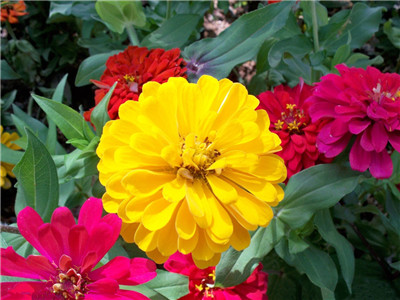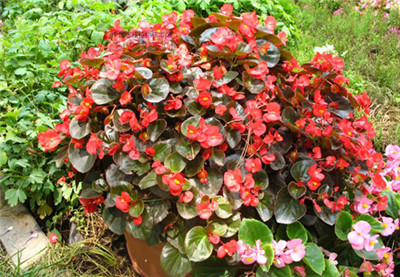Breeding techniques of zinnia
Zinnia is an insect-pollinated flower, and the excellent flower color varieties are often cross-bred due to natural pollination by insects, in which the ones that get better are less and the ones that become worse are more, while the double-petal varieties tend to deteriorate to single-petal ones, and the flower color also becomes dim and without velvet luster. In order to maintain the good quality of zinnia, it is necessary to select excellent, prevent impurity and keep pure. Every year, the single plant with large petals, bright color and the smallest flower heart is selected from the flower bed as the attentive plant, and the whole plant is covered with a transparent plastic film bag for self-pollination. The seeds of a single plant are sown and raised separately, which are more than 200 meters away from the flower bed of other zinnia, and the deteriorated monopodium plants are pulled out at the beginning of flowering. In this way, the excellent original species of double flower can be obtained by continuous purification. If you want the original double flower of flower color, it is more necessary to remove all the double flower plants of different color when purifying and removing impurity, so as to prevent the hybridization and variation on the flower color. In addition, because zinnia is a kind of Chinese and Japanese flowers with early flowering, the length of vegetative growth period is not limited by the length of sunshine, sowing in spring, summer flowering in summer and autumn flowering in summer. For example, red double flower varieties are propagated in spring and yellow double flower varieties are propagated in autumn, and the tail flowers of the former are removed when the latter begins to bloom, so as to prevent hybridization and variation in flower color.
Zinnia is a natural cross-pollinated plant, so its offspring vary greatly. In order to select varieties with excellent characters, continuous multi-generation single plant selection method is often used in conventional breeding to achieve the purpose of optimization.

The details are as follows:
1. Cultivate strong seedlings to increase the resistance of varieties. Ensure proper row spacing and promote the robust growth of plant vegetative bodies.
2. Continuous multi-generation optimal cropping was carried out in the whole growth and development process, such as seedling stage, growth stage and flowering stage, so as to remove impurities, differences and diseased plants in time. When planting, the mother plant was isolated, and the interspecific isolation distance was not less than 600 meters. And pull out miscellaneous varieties; according to their growth habits, create a good cultivation environment, avoid continuous cropping. Such as poor cultivation conditions, barren soil, too dry, easy to appear poor flower color, small flower diameter, double into single-petal variety and so on. For the mother plant that chooses to retain seeds, it is necessary to strengthen the management of water and fertilizer so that its excellent characters can be fully displayed, and the seed setting rate of double flowers can be improved by pollination.
3. Seed harvest: the florescence of each floret is different, which is about 30 days, and the ripening period of achenes is also uneven. The head flowers and lateral flowers with maternal characteristics were harvested respectively to remove miscellaneous species. Then the treated seeds were placed in an airtight and low temperature condition to ensure the germination rate of the seeds.
- Prev

Cultivation Techniques of Canna indica
Full sunlight. Canna requires sufficient light during its growing season, ensuring that it receives at least 5 hours of direct sunlight per day. Too much darkness and insufficient light will delay flowering. If placed in a cool place at flowering time, flowering can be prolonged
- Next

How to cut begonia in four Seasons?
Four Seasons Begonia leaves delicate and bright, flowers in clusters, bright color, four seasons open, is an excellent family pot. The cuttings of four seasons crabapple do not need to be too long. It is recommended that the cuttings should be less than 10 centimeters. Too long cuttings will lead to difficulties in water transmission, branch support and decay.
Related
- Fuxing push coffee new agricultural production and marketing class: lack of small-scale processing plants
- Jujube rice field leisure farm deep ploughing Yilan for five years to create a space for organic food and play
- Nongyu Farm-A trial of organic papaya for brave women with advanced technology
- Four points for attention in the prevention and control of diseases and insect pests of edible fungi
- How to add nutrient solution to Edible Fungi
- Is there any good way to control edible fungus mites?
- Open Inoculation Technology of Edible Fungi
- Is there any clever way to use fertilizer for edible fungus in winter?
- What agents are used to kill the pathogens of edible fungi in the mushroom shed?
- Rapid drying of Edible Fungi

